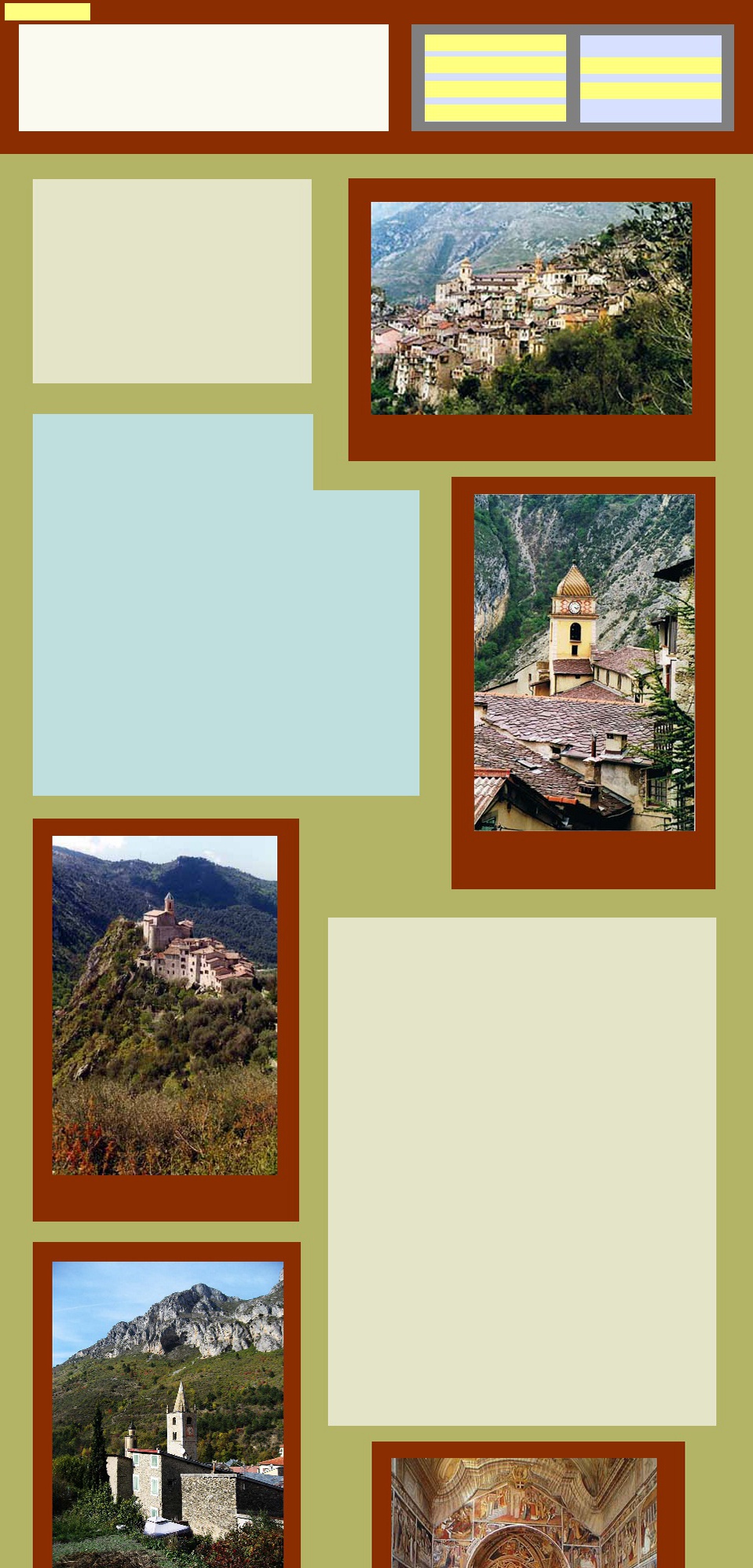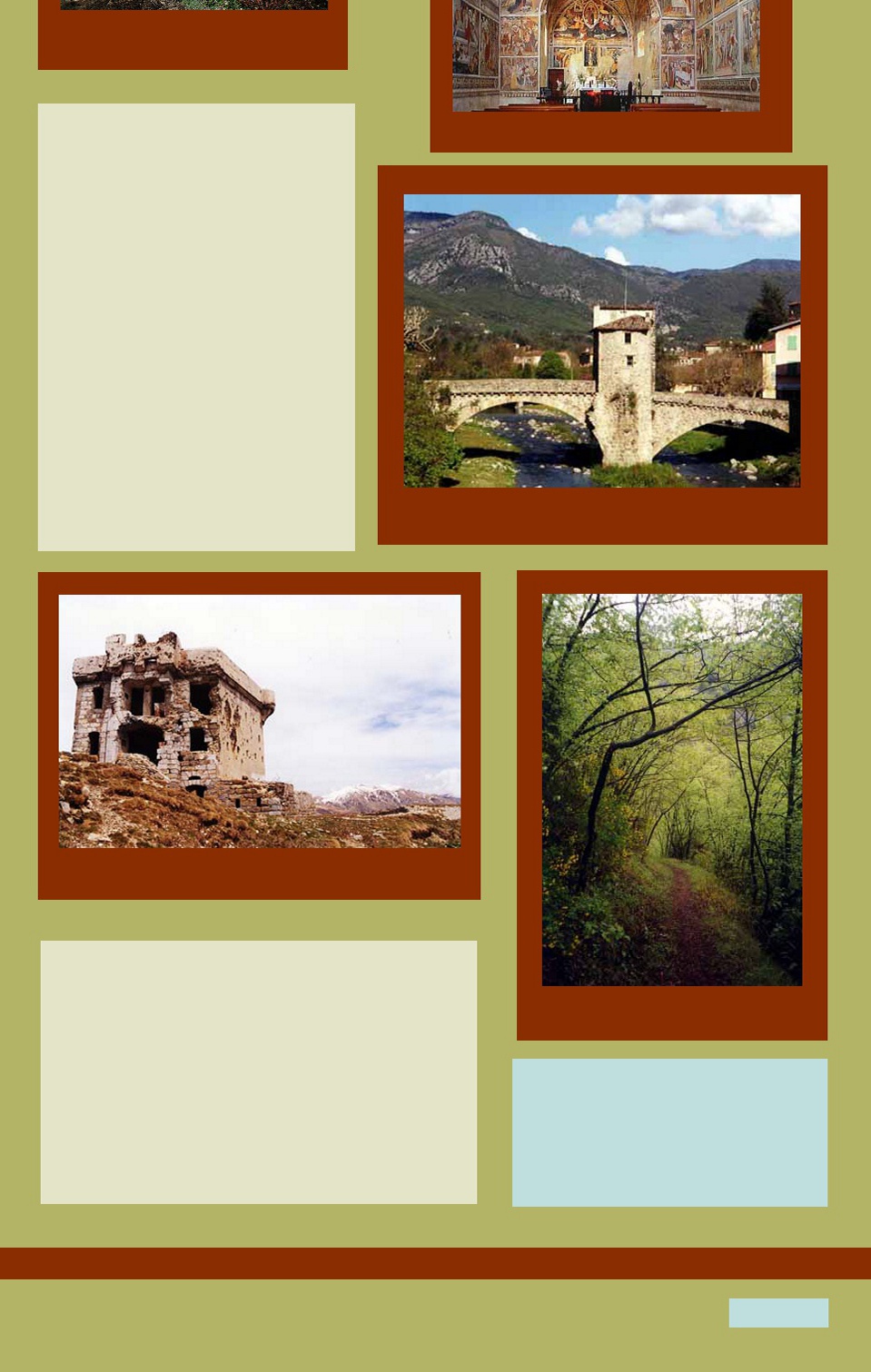

Les Alpes Maritimes
Perched Villages and
Painted Churches
North of Nice and between the Vesubie and Roya
Rivers is a stunning area of mountain valleys and
formidably rugged mountain country.
You are nearly in Italy here and there is a character
noticeably different to the flashy and flamboyant
Mediterranean resort towns or the grandiose high
Alps to the North. This is largely because, after
centuries of bouncing backwards and forward as a
political pawn, much of this area only became part
of France in 1947 following the end of the Second
World War.
The Frontier between France and Italy
The French Département centred upon Nice has a long
history of shifting allegiances, understood only after
some research into the history of the Kingdom of
Piedmont and the part that it played in the unification of
Italy.
In brief, we discover that from as early as the 14th century Nice was ceded
alternatively to France and the House of Savoie, the rulers of Piedmont.
Towards the end of this saga, it was taken by Napoleon but returned to Savoie
on his defeat. However Austria, as one of the main beneficiaries of the
Congress of Vienna, maintained a strong position of occupation in all of
northern Italy.
In the struggle to evict the Austrians in the lead up to unification, Napoleon
III agreed to assist King Victor Emmanuel II of Piedmont on condition that
Nice be returned to France. This duly happened but without the region of
the Haut Roya which was allowed to stay within Piedmont (subsequently
Italy) because the royal house had long established hunting grounds there.
The situation was only finally resolved following the second world war
when, with Italy defeated, a plebiscite was held and, in accordance with
the wishes of the people, the Roya lands were finally reunited with France
and the boundary came to its present geographical position along the
partage of the waters.
Perched Villages
Perched high up in the hills are picturesque villages, built to withstand
attack from the successive invasions. Now safe, some have fallen into
disrepair but most have being undergoing the restoration so typical of the
most attractive isolated villages throughout France.
You see the villages perchés from far away and wonder how on earth they
can be reached. Then you see a road, winding round and round the
perched eyrie and if you have the courage you take the nail-biting narrow
road and eventually reach the outskirts of a village. You abandon your car
and walk up narrow streets, up and down stairs, through archways to
more stairs and still upwards till you reach a church at the very top. Our
favourites were Tende, Saorge and Peillon.
The churches in these villages are decorated with colourful paintings in
the naïve 15th century Italian style. A number of celebrated artists made a
living travelling from village to village decorating churches in this most
distinctive and exuberant style. The very best, however, is not in a
perched village but in the tiny Chapelle Notre-Dame-des-Fontaines in an
isolated location beside one of the little streams of the Haute Vallée de la
Roya.
At the time of our visit, inspections of this little church were being
closely monitored because a prized statue had recently been stolen.
The custodian of the local tourist office in La Brigue came with us in
our car to unlock the church and provided additional information. Now
there are established times for visits.
Incredibly detailed and brightly coloured frescoes entirely cover all the
walls of the chapel depicting the stories of the life and death of Christ, the
resurrection and the Last Judgement. From the times when people didn't
read, the graphic lessons in these frescoes are infinitely better than many
thousands of words. The rarely awarded three stars of the Michelin green
guide reinforce the specialness of this experience.
Walking
When it comes to walking, the picturesque small
town of Sospel is a good base. A fan of GR's, all
deriving from the GR 5 converge here, to finish their
journey together to the Mediterranean at Menton.
There are opportunities to follow the GR 51, 52 and
52A and there are also many shorter walks some of
which have been detailed in a brochure produced by
a local walking group. We spent a few days
enjoying these walks and also explored an area to
the north west where there were 360 degree
panoramas of the mountains bordering France with
Italy.
To our very great surprise we also came upon the
well preserved remains of the fortresses of the
Maginot Line built in the aftermath of World War I to
protect France from any future invasion by Germany.
This line of defences was constructed between
1929 and 1940 - a massive, state-of-the-art defence
system of underground fortresses and tunnels
linked by tramways to transport machinery,
armaments and supplies. It ran virtually the length
of the country.
History tells us that the northern line of defence failed to stop the
German invasion along the Belgian frontier in World War II. However, the
southern line worked perfectly, crushing an offensive by the Italians
attempting to take Nice. An Italian army of 350,000 attacked along a line
from the Swiss border to Menton on the Mediterranean but the defences
held and the invaders were stopped in their tracks.
Now largely forgotten, the relics of the Maginot line are visited by walkers
in the mountains or military historians who love to relive history and
climb all over the ruins.
This is a refreshingly different area not greatly
visited by tourists. It was therefore even more
amazing to see that the wine list in our Sospel
hotel included several Australian wines. The patron,
it eventuated, was a frequent visitor to Australia and
loved the wine so much that he had bought great
quantities to cellar and serve in his restaurant.
Return to Top
The perched village of Saorge
The rooftops of Saorge
Peillon on its hilltop
La Brigue sits in a valley beneath limestone cliffs
Interior of Notre-Dame-des-Fontaines
©peintures murales.free.fr
Restored bridge in Sospel
A damagted fortress on the Maginot line
A forest pathway near Sospel
Explore on MAPS
Visit ITALY
Visit SPAIN/PORTUGAL
Explore FRANCE
Return to HOME PAGE
Explore PHOTO GALLERIES